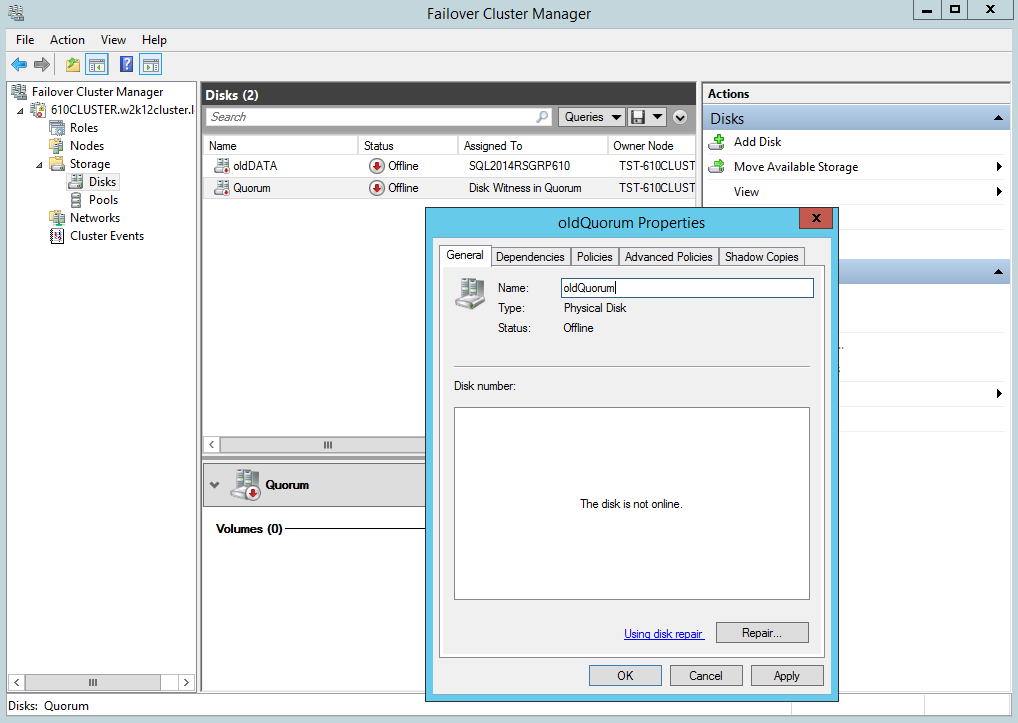Environment
This document describes the procedure for re-configuring a
Microsoft Windows 2012 R2 cluster environment (that is, either Windows Cluster
Service or a Windows Fail-over Cluster) after a PlateSpin Forge or PlateSpin
Protect failover/failback occurs.
Situation
Assumptions
This procedure assumes that the Protect/Forge user has run a
full failback to the physical target and that shared storage is not yet
attached.
It also assumes that the network infrastructure requirements
(like Gateway, DNS, access to Domain Controller, etc.,) for Windows Cluster is
verified and updated (if needed).
Resolution
Restoring a Windows 2012 R2
Cluster after Failback
To restore the cluster after failback:
1. Log in to the failback computer.
2. Attach the shared storage (for
example SAN storage connected via Fibre Channel or iSCSI storage).
3. (Conditional) â if the former shared storage drives (that is, the old cluster disks) are online. In the Windows Disk Manager, change the drive letters of the old cluster disks to some other drive letter to prepare for assigning the original drive letters to the re-attached shared storage drives.
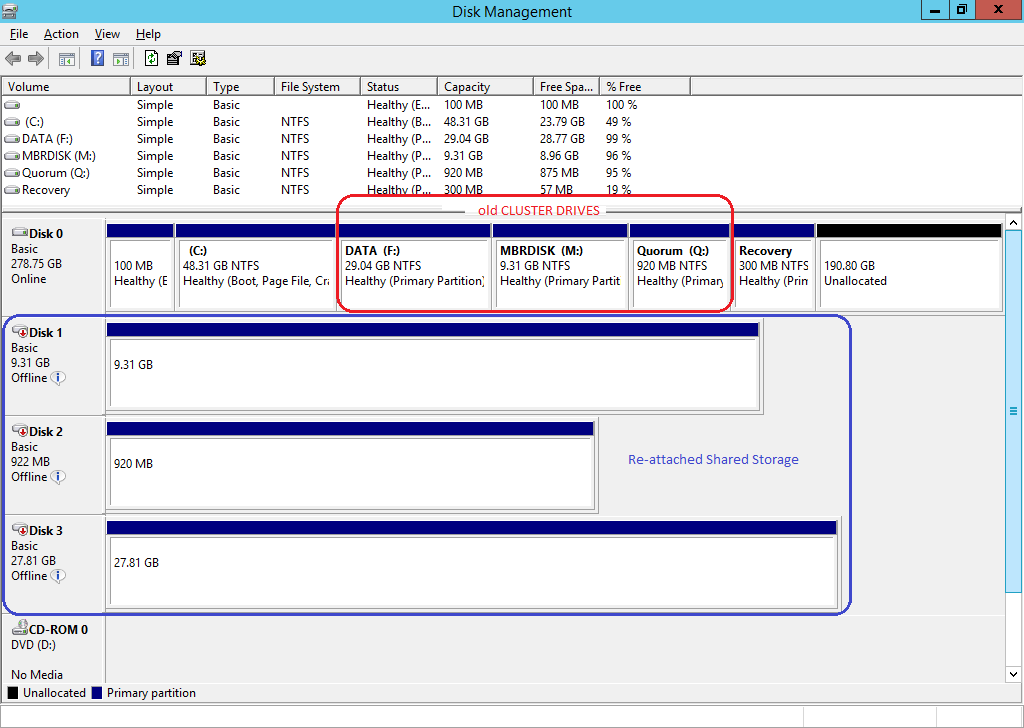
to
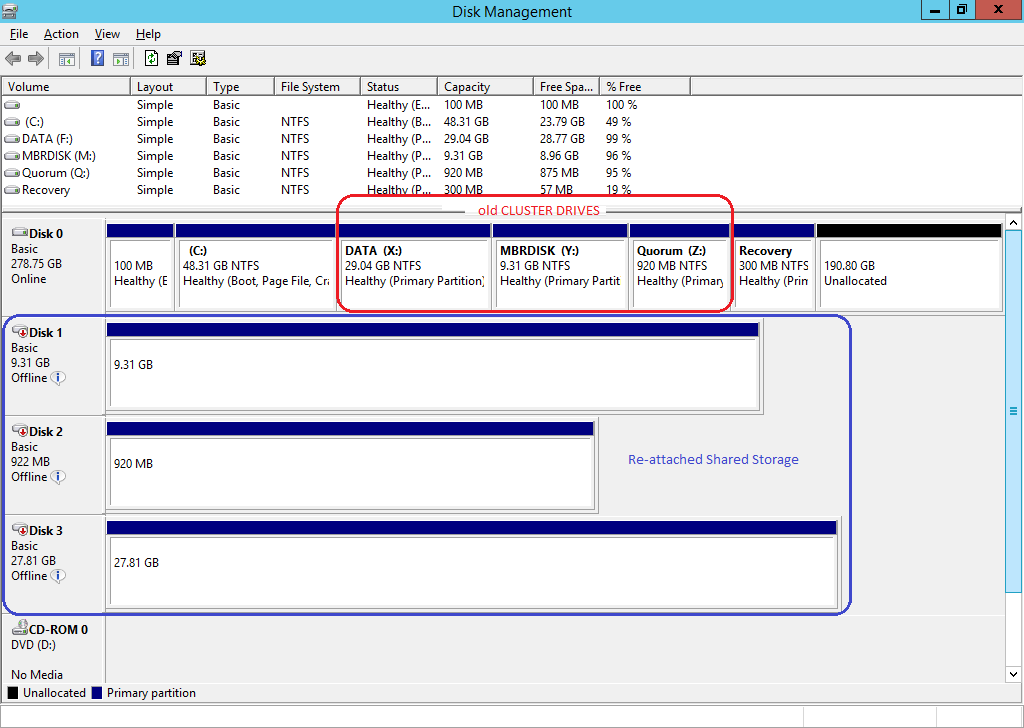
NOTE: Even if the cluster disks are not currently displayed with an Online status, they are brought online in Step 14.
4. In the Windows Disk Manager, bring the newly attached shared storage online and reassign the original drive letters to these shared drives.
5. Start the Cluster service using the /fixquorum switch. If the Cluster service is already running, stop the service and restart it using this switch.
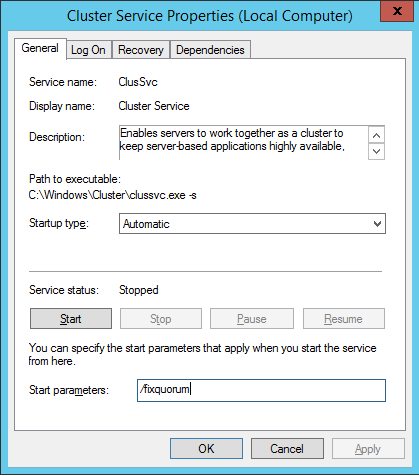
6. In the Failover Cluster Manager, expand the Storage folder and click the Disks folder. Right-click each disk and select Properties to rename the cluster storage disks to something other than the original name (for example, oldQuorum, oldDATA).
7. In Failover Cluster Manager, select the Nodes folder, then right-click the orphaned node > More Actions > Evict.
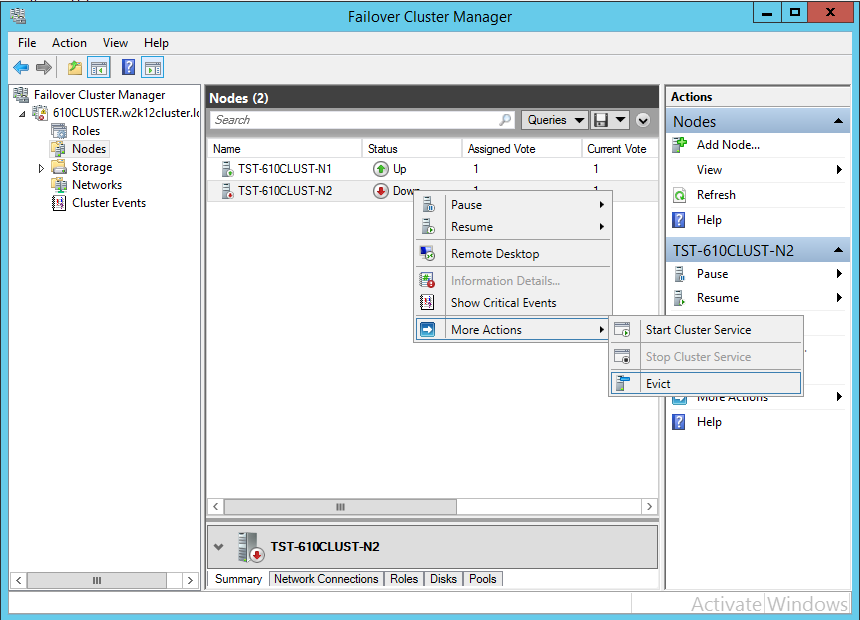
NOTE: You might receive a warning that the orphaned node could not be cleaned up. Follow the directions in the message for more information.
8. Add new shared storage as available Cluster shared disks.
1. In the Failover Cluster Manager, right-click the Storage folder > Add Disk.
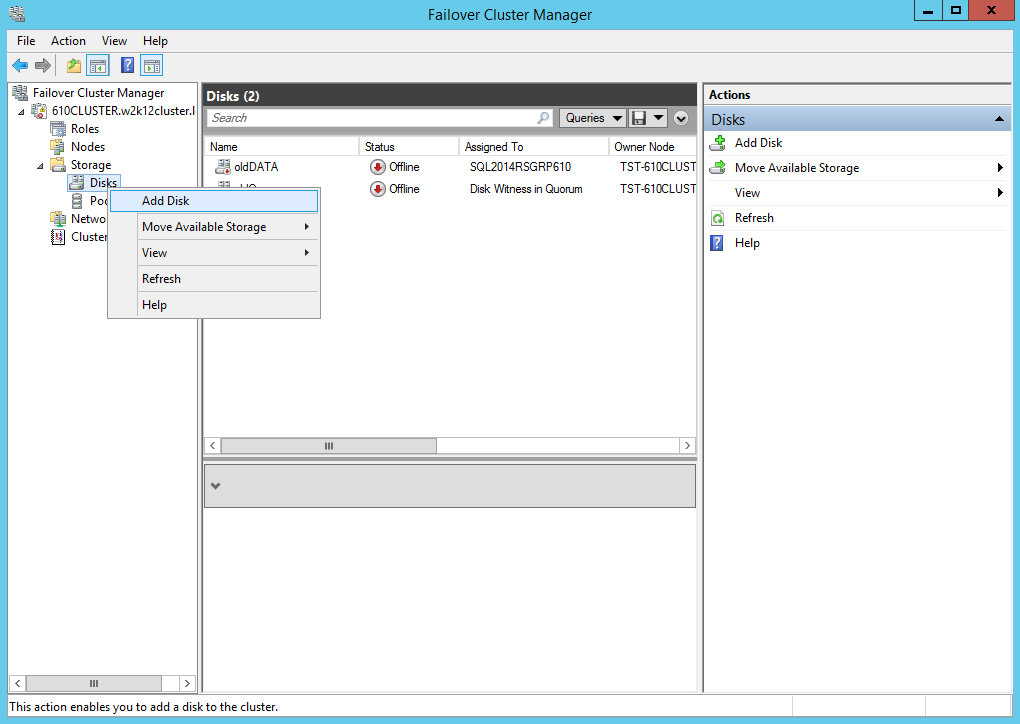
2. Select the available shared disks and click OK.
3. (Conditional) If you receive this error message:
No disks suitable for cluster disks were found
you can add the disks by using the DISKPART utility to retrieve the Disk ID for each shared disk you add, and you can use the cluster resource command to add the disks, to assign an ID, and to bring the disks online:
1. From a Windows command line, start the DISKPART utility and run the List Disk and Select Disk commands to select a newly attached shared disk, then run the Detail Disk command to retrieve the Disk ID for that disk. Note the Disk ID.
NOTE: For MBR disks the disk ID will be a 8 character DiskSignature. For GPT disks, the disk ID will be a 32 character {DiskIDGuid}.
2. Repeat Step 8.3.1 for each shared disk you are adding.
3. From the Windows PowerShell command prompt, run the cluster resource command with the proper parameters and value names to âcreateâ each disk to be added. For example:
Add-ClusterResource âName Quorum âResourceType âPhysical Diskâ âGroup âAvailable Storageâ
(where "Quorum" is the name you want to associate to the added disk)
4. From the Windows PowerShell command prompt, run the cluster resource command with the proper option to assign a Disk ID (retrieved and recorded in Step 8.3.1) to each disk created in Step 8.3.3. For example:
Get-ClusterResource Quorum | Set-ClusterParameter DiskIDGuid â{DiskID}â for GPT disks
Get-ClusterResource Quorum | Set-ClusterParameter DiskSignature 0xDiskID for MBR disks
5. From the Windows PowerShell command prompt, run the cluster resource command with the proper option to bring each cluster disk online. For example:
Start-ClusterResource Quorum
9. Reconfigure the cluster quorum disk to use the newly-added shared volume designated for the Quorum disk:
1. In Failover Cluster Manager, right-click the cluster object, select More Actions > Configure Cluster Quorum Settings to launch the Configure Cluster Quorum Wizard.
2. On the Select Quorum Configuration Option page, choose âSelect the quorum witnessâ option.
3. On the Select Quorum Witness page, choose âConfigure a disk witnessâ option
4. On the Configure Storage Witness page, select the newly added storage volume you want to assign as the quorum disk.
5. Click Next to complete the configuration and then Finish to exit the Wizard.
10. In the Failover Cluster Manager, add the newly-created shared disk for the cluster resource application:
1. Expand the cluster object and
click Roles.
2. In the Roles pane, right-click on the desired cluster resource or role (in this example figure below, the MSSQL Server 2014) and select Add Storage.
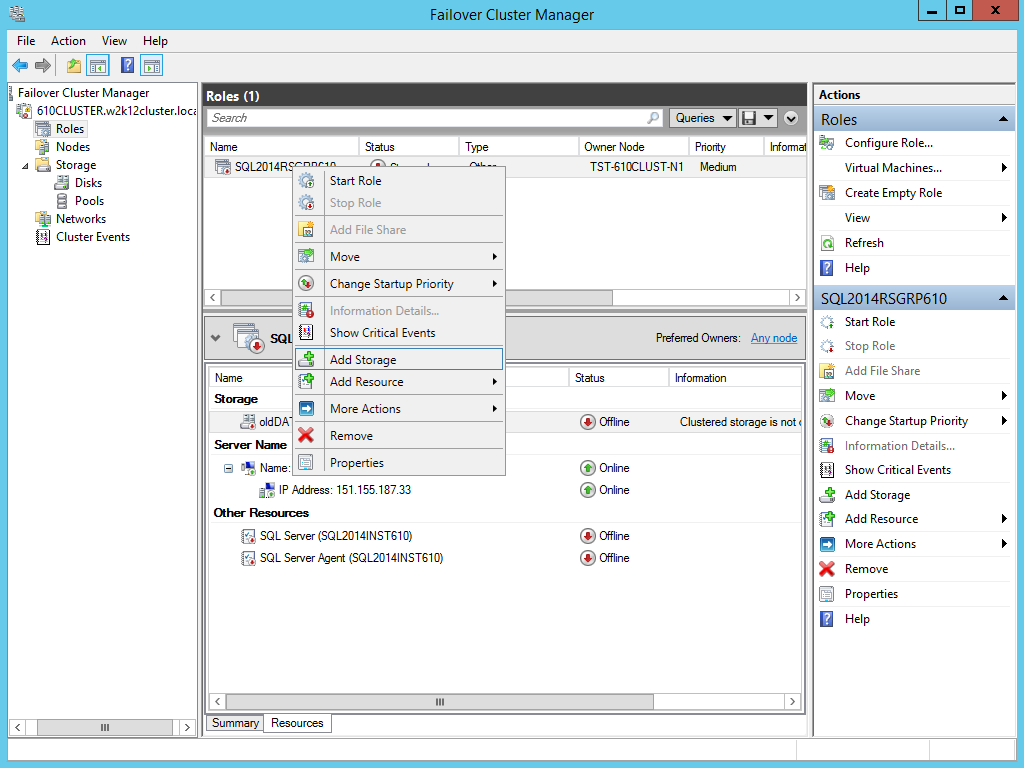
3. In the Add Storage dialog box, select the new disk you want to add for the cluster resource.
11. Change the dependencies on the âOther Resourcesâ for the cluster resource or role being configured to use the newly-added storage disk:
1. In the Failover Cluster Manager, click on Roles, then select the cluster resource or role being configured.
2. In the bottom of the Roles view, select the Resources tab.
3. In the Other Resources section, right-click on a resource specific to the role being configured and select Properties, then the Dependencies tab.
4. On the Dependencies tab, click on the row showing the shared disk being used to expose the drop-down menu. Change the disk assignment to the newly added shared disk.
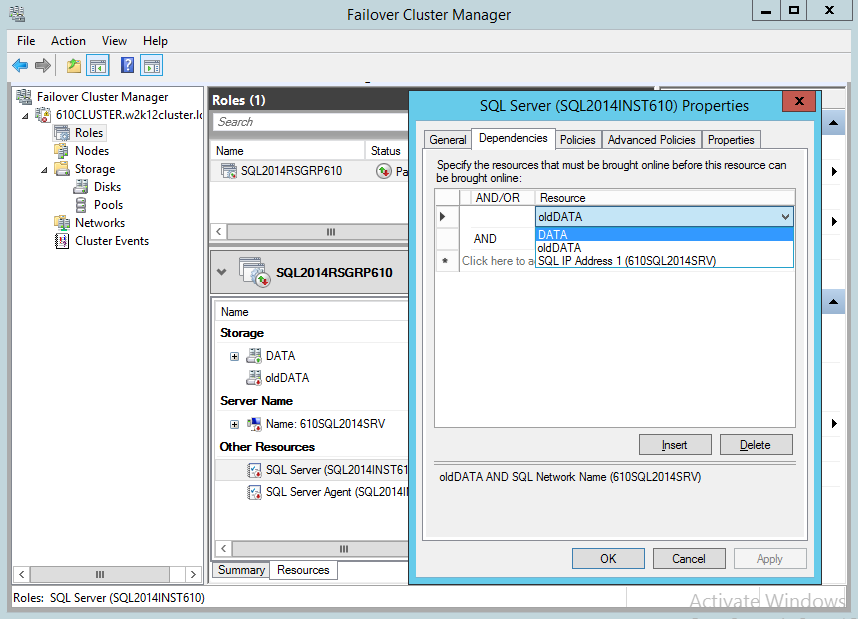
NOTE: You will have to repeat this step for each service associated with the cluster resource or role you are configuring.
12. Remove the old cluster resource disks that are no longer being used.
1. In the Failover Cluster Manager, click on Roles, then select the cluster resource or role being configured.
2. In the bottom of the Roles view, select the Resources tab.
3. In the Storage section, right-click on the old unused cluster resource disk, select âRemove from <Cluster Resource Group>.
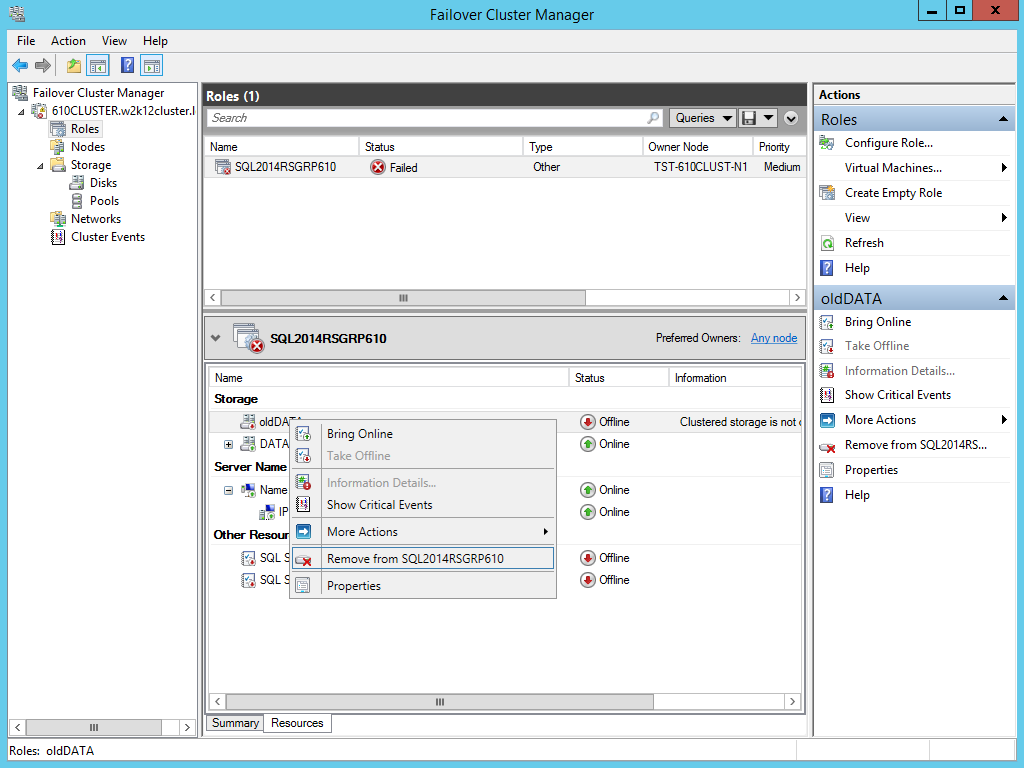
13. In the Failover Cluster Manager, select Storage > Disks to show the currently configured cluster disks. Right-click the old storage drives that are no longer needed and select Remove to delete them from the cluster configuration and to allow them to operate as local disks.
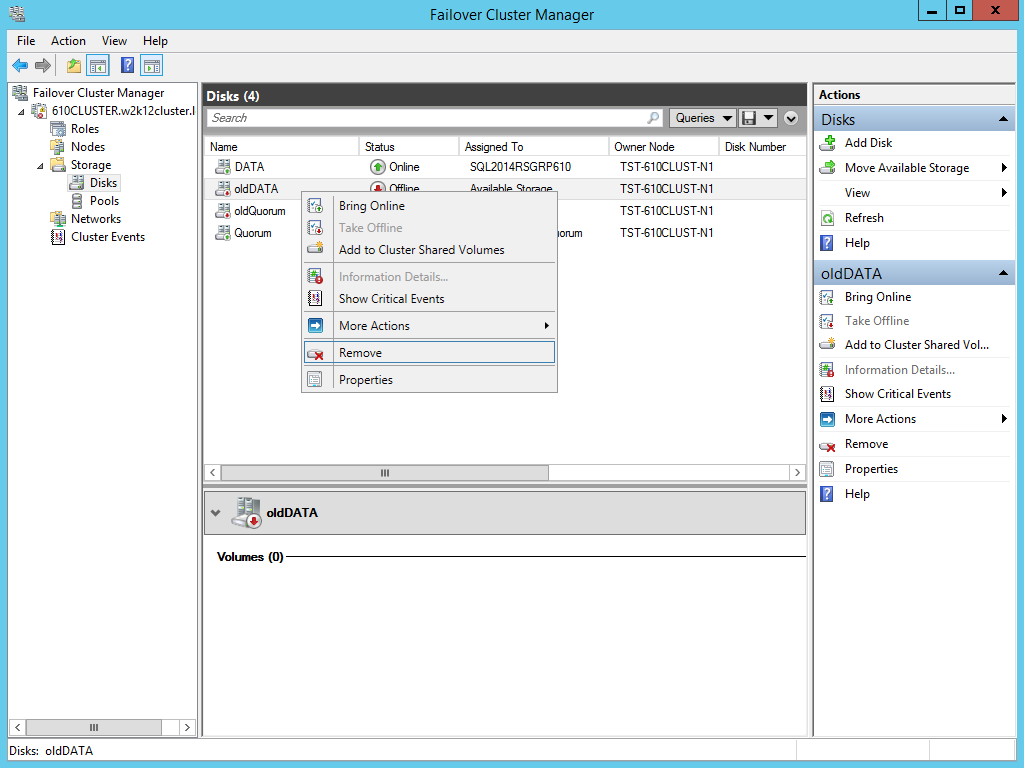
14. (Conditional â if old cluster disks were not online in Step 3 or are not currently online). In the Windows Disk Manager, bring the old cluster disks online as local disks and assign them a drive letter.
NOTE: Now that these disks have been removed from the cluster configuration in the Failover Cluster Manager, they will act as local disks.
15. From the command line, perform an xcopy of the application data from the old cluster resource disk to the new cluster resource disk. This ensures that security permissions persist.
You can use any of the following switches in this scenario:
|
Parameter |
Description |
|
/o |
Copies file ownership and discretionary access control list (DACL) information. |
|
/x |
Copies file audit settings and system access control list (SACL) information (implies /o). |
|
/e |
Copies all subdirectories, even if they are empty. |
|
/h |
Copies files with hidden and system file attributes. (By default, xcopy does not copy hidden or system files.) |
|
/k |
Copies files and retains the read-only attribute on Destination files if present on the Source files. (By default, xcopy removes the read-only attribute) |
Syntax example:
xcopy x:\*.* f:\ /o/x/e/h/k - where x: is the oldDATA (with protected data) drive and f: is the new DATA drive
16. In the Cluster Failover Manager, bring all cluster drives and roles online.
17. In the Windows Disk Manager, remove all old cluster drives that are no longer needed.
18. Manually remove the PlateSpin Cluster Driver.
WARNING: Using Registry Editor incorrectly can cause serious problems that may require you to reinstall. There is no guarantee that problems resulting from the incorrect use of Registry Editor can be solved. Use Registry Editor at your own risk.
Before you make changes to a registry key or subkey, we recommend that you export, or make a backup copy, of the key or subkey. Follow Microsoft's Online Resources to find how to correctly use Registry Editor and to take backup of the registry.
1. Launch the windows registry editor (regedit.exe)
2. Browse to the registry key:
HKLM\SYSTEM\CurrentControlSet\Control\Class\{4D36E967-E325-11CE-BFC1-08002BE10318}
3. Remove the "PsCluHlp" string from the "Upper Filters" value in this key
Note: Ensure that you do not delete the entire value, only remove this string.
4. Delete key "HKLM\SYSTEM\CurrentControlSet\Services\PsCluHlp" and all of its subkeys.
5. In the windows file system, delete file %WINDIR%\system32\drivers\PsCluHlp.sys driver file.
The cluster now functions on a single cluster node.
19. Connect additional nodes and add them to the cluster.
